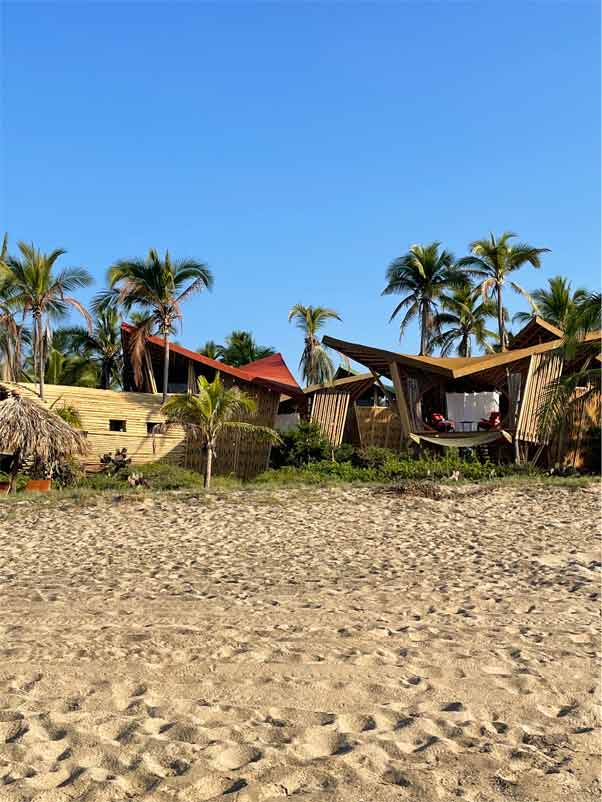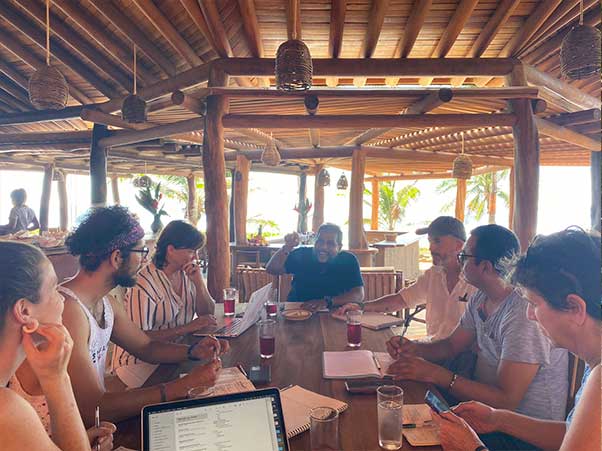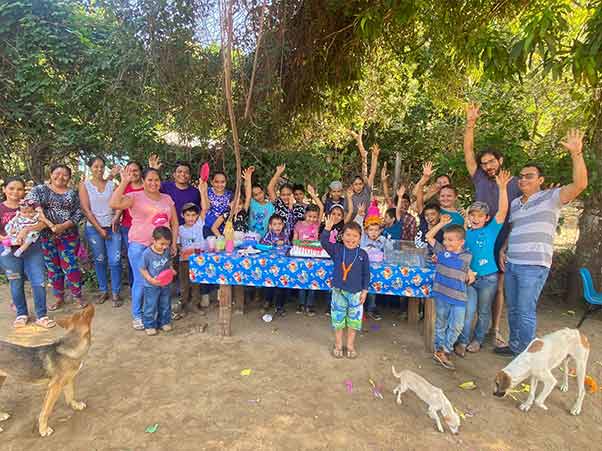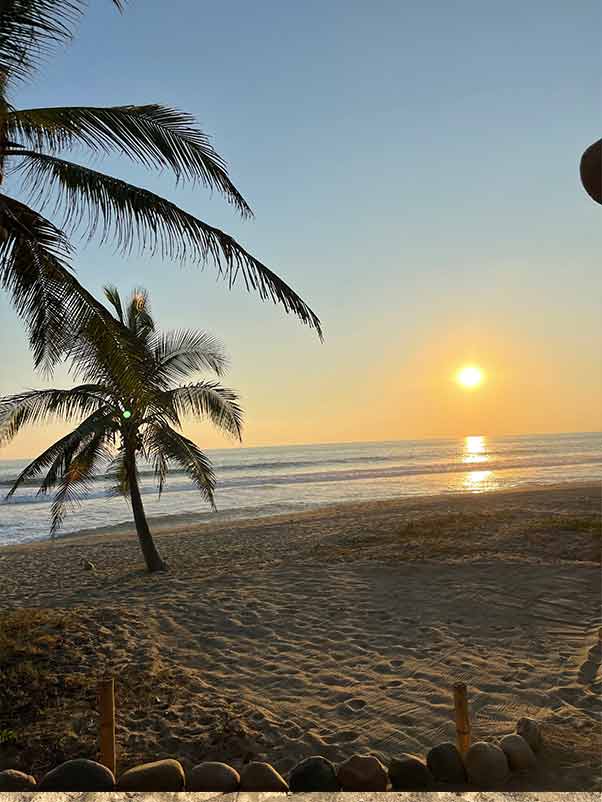Originally Published by Linda F Nathan, on her blog
Regeneration: Problem Solving in a Mexican Watershed
ReSiMar is a project in Mexico that focuses on large-scale, community-driven transformation to regenerate Mexico’s coast in Baja, Oaxaca and Guerrero. Specifically, the name is an abbreviation for “regeneration of sierras/mountains and mar/ocean.” The founders have experience in Water Culture, Education, Permaculture, Fisheries and Resources, and Ecosystem Restoration. They believe in the regenerative vision of these diverse networks to bring improvements and increase human abundance. In other words, people need to have better lives and living conditions.
For an intense week in mid-December, I participated in the work of ReSiMar and called Playa Viva home. Playa Viva is an eco-resort right on the beach at the end of the Juluchuca watershed, south of the Ixtapa/Zihuatanejo resort area in Guerrero, Mexico. Hotel Playa Viva has operated in the Juluchuca area for 12 years and has developed deep roots and trusting relationships with community members. David Leventhal, the Mexican-American founder, refers to his hotel as “a place where travel meets one’s values.” This stunning property consists of more than a dozen bamboo tree houses of assorted shapes, a large common area/dining area, (where there’s wifi); swimming pool, and two yoga studios. The sound of crashing waves can be heard everywhere.
For ReSiMar, the hotel serves as a “base camp” for meetings, meals, planning and project development. Everyone who arrives is included, no matter anyone’s age or experience. I was there as a guest of my HGSE graduate student, Patricia Vazquez, former minister of education in Puebla, a recent friend and partner of ReSiMar and now coordinator of the education node. (The word node is used frequently in this project).
All fall semester, I had read her papers as she continued to develop ideas about how to improve the schools in the area, but I couldn’t really capture the connections until I visited. Paty kept using the word “regeneration” in her writing. Now, I’m not sure I’ll ever think the same about education. I came to understand that the success of regeneration depends on the interconnection between people, land and water. The way ReSiMar works to forge those connections is through experiential/hands-on learning, community governance, and storytelling.
Clean water is fundamental, but ReSiMar understands that just cleaning the water without connecting it to education and economic growth is insufficient. There are over 750 watersheds in Mexico and too many have experienced both environmental degradation and limited economic opportunity and that has led to forced migration.
Our first day illustrated the importance of clean water and the role of storytelling to ReSiMar’s project. Following a 20 kilometers ATV ride up steep mountain roads, we arrived at the compound the Gutierrez family calls home. Don Efrain was my ATV guide and teacher. He has grown up farming in this region, knows everyone, and could easily reference the ways in which people, land and water can be in tension. As he talked and commented on what we were seeing along the road, I held on, fearful of being thrown off over a mountain. When I complained of an aching shoulder and arm, Don Efrain told me I had to learn to lean into the curves. We arrived at the homestead or Rancho of the family after about 2 hours of winding steep roads and crossing rivers. The Gutierrez family have lived at the very top of the watershed since the early 1930s. They have approximately 100 hectares/acres of land. Don Jesus, the elder of the family, regaled us with tales of cock fights, robberies, murders, and rum to describe how the family built the incredible rancho. The grandchildren, playing on the floor, listened in rapt attention, too. The pedagogy of storytelling was apparent. The family has developed an essentially sustainable lifestyle cultivating their own crops: coffee, cacao, sugar cane, corn, beans and many other fruits and vegetables. They have cattle, chicken and pigs as well.
After Don Jesus’ stories had come to a close, we ate a delicious fresh meal of tortillas, cheese, avocado, beans and toppings; our dessert was freshly pressed sugar cane juice. Full and happy, we took a walk through the property and then swam in a crystalline river with the younger grandchildren. While the lifestyle at the Gutierrez rancho may seem idyllic, it was also clear that the three times daily preparation of tortillas, and the challenges of making ends meet selling coffee and chocolate to tourists like us, did not come without sacrifices. At one point Don Jesus admitted that he, too, had had to sell off trees, and more than he was actually allowed, just to pay the bills. “I took down too many. I needed the cash. I knew then it was a mistake. But I had no choice.” When too many of the trees are cut, the soil begins to erode and then the dangers of pollution increase. “We planted back quickly. The water is still pure here.” Again, the role of regeneration was becoming clearer, but not without its complications. How do people, land and water live and grow in harmony?
The clean water that fuels the Gutierrez rancho and served as the setting for our time playing with the grandchildren is not a given in the rest of the watershed. As we wound our way down and stopped at the various rural schools that dot the watershed, the imbalance between people, land, and water was evident due to the impact of environmental degradation.
The one room schoolhouse, just down the road from Don Jesus’ rancho, in the hamlet of Las Placitas, enrolls about twenty-two children. On the day we arrived, during the middle of the Posadas, the celebrations before Christmas holidays, ebullient and immaculately dressed children greeted us in between playing rounds of “Mar y Tierra,” a Simon-says like game, and busting open candy-filled piñatas. The screams of laughter were contagious as children scrambled for their share of candies. As mothers arrived with special lunches (they bring lunch every day for their children), we wandered into the classroom where everything from children’s cubbies to reading books had a place. The reading books were plentiful, although haphazardly arranged on a shelf. Still, the echo in the classroom was intense and I could imagine the noise level with all the children inside. Open air seemed like a better option for learning. There were lots of tables and chairs outside, but no shelter to keep off the sun. Also, although the play area was large and the field extended beyond the play area, there was no garden or cultivo. Although the physical conditions of the school are sub par, the students are enthusiastic learners and successfully compete with others in the watershed with their academic accomplishments, thanks to their excellent teacher, Profe Belen.
I walked over to use the bathrooms—two outhouses– and was shocked by what I found. They were completely fetid and flooded. How did the children use these stalls? I found out that they didn’t. “I tell my daughter she has to hold it til the end of the day/Yo le dije a mi hija que aguante hasta que termine el día,” one mama acknowledged. The younger children use the perimeter of the school yard if they have to go.
The next school was not much better, but the last schools, back in the town, had much better facilities—one even had a science lab! Clearly, the state has funds for some, but the most isolated schools have been overlooked.
As we debriefed the day, discussing our various journeys to schools, farming communities, or other sites, we kept returning to the question of water and sanitation. Deforestation and pollution endanger the community; lack of clean bathrooms stood out.
Throughout these debriefs, I was struck with the way this group has embraced community knowledge and expertise. James, our appointed facilitator, asked us to make connections across the different nodes. What did “Water” have to teach the Education node? What were we learning from one another and our community of teachers? Even though there are very educated and influential Mexicans, Americans and Europeans involved at Playa Viva, no one has more say than someone who is from the area and lives there. “Have we asked the end user?” was a continual question and allowed everyone to take time before jumping to conclusions about what should happen next.
To illustrate this way of teaching and learning, we had a discussion about a wealthy donor who was willing to pay for re-digging and re-building the trenches for the latrines at the school. One of our group members was ready to embark on the mission of new latrines, but when the local teacher said that they would just flood again, there was a pause. Members of the Water node joined our discussion and a new idea emerged: dry toilets. We discussed this new technology; wondered about whether anyone in the Juluchuca watershed had seen one and, finally, decided to re-engage the donor and see if he would move more slowly and allow education about dry toilets to happen first which might include visiting them in another state. “Hay que educar a las mamás/One has to educate the mothers,” Profe Belén told us. “Tienen que ver que los baños secos son mejores. They need to see that dry toilets are better.” We knew training on dry toilet maintenance would take some time. I was stunned by the way the conversation and decision making had occurred. I had been so ready to jump: fix the problem! Give the children sanitary conditions! However, by working alongside others not in education and by asking about the end user, we came up with a different decision. Was this Regeneration at its best?
Besides its investment in the schools (Playa Viva has raised funds for additional teachers), there is also a farm on the property that uses permaculture practices. The farm is run by a white woman from Maryland. At first, this surprised me. How would Mexican farmers take to her? When we got to the farm and saw what they had collectively created and how the female director invested in and respected the expertise of her crew, I understood. “I may have the experience and the theoretical knowledge about permaculture farming, but they know this land. Together we are building a unique place that we hope will make money.” Amanda, the head, has hired two women to run the nursery. “Production has increased tenfold since they were put in charge. We can’t keep up with demand.” There is an outdoor classroom here (something lacking at the actual schools up the watershed). “Here is where the children can learn about companion planting and the value of pigs, for example. We need to expand our teaching practices.”
This made me think about the possibilities for how outdoor educators, farmers and teachers could collaborate to share knowledge and experiences.
Again, outdoor education on a farm and the possibilities of outdoor education at a rural school could share knowledge and experiences.
The other place where strong teaching occurs is the turtle sanctuary. 750 meters down the beach from the hotel is both the sanctuary and another outdoor classroom where one can learn about the Golfina turtles as well as other species in danger of extinction. If the timing is right and nature is on your side, in the early dawn or late at night, you can release them into the ocean. (Only about 2 out of 1000 will survive). Spread out over a quarter of a football field is the hatching and protected area, clearly marked and labeled. Lorenzo, a biologist from Italy, directs the sanctuary and explains that he has brought on and trained many from the community to maintain and teach about the turtles—their special habitat and value. It was a magical moment to arrive before the sunrise and actually release turtles into the sea.
Each day of our work included an afternoon meeting where participants shared what they had learned and what new ideas that had generated. We answered three questions to begin our discussion:
1) What was your expectation?
2) How do you feel?
3) Who are you?
I was continually struck by how those simple questions generated a shared understanding of what we could accomplish together.
Like so many of us, I am often overwhelmed by the urgency of all the problems in education. I’ve always been a fixer (and I think a fighter). But after this week, I am thinking more about the role of storytelling to solve seemingly intractable problems. I always encourage my adult students to put their students at the center of their work. That has taken on new meaning after working with ReSiMar. What does it mean to be transparent about one’s expectations? When I enter a situation, I am bringing my biases and experiences. It’s important to acknowledge those in order to keep growing and learning. While feelings often are dismissed as being soft or even irrelevant, after this week, the ability to listen to everyone’s feelings and to acknowledge, again, the role that they may play in how problems are analyzed and solved has become more central for me.
Perhaps our approach to these three questions helps us to think more expansively about regeneration. I know for me I am thinking more deliberately about how people, land, water connect and what that may mean for my field: education.
Our last meeting took place in a circle in the swimming pool which seemed appropriate given our level of exhaustion and dust from our travels. This time our questions included: What three words are you leaving with? Many of the previous circle discussions had focused on the fact that progress only happens at the pace of trust– a mantra that all seemed to embrace here. For me the final words came easily:. “Love, revolution and network.” The love of the land and the people was so evident here; the revolutionary ways that individuals and groups were attacking problems was inspiring; the power of the network reigned. I was reminded of something Jane Goodall said years ago about saving forests and species by creating better lives for people. ReSiMar is a beacon of hope for what is possible when regeneration is at the center of the work.
For more information about ReSiMar please contact:
colleen@playaviva.com or patricia_vazquezh@yahoo.com





